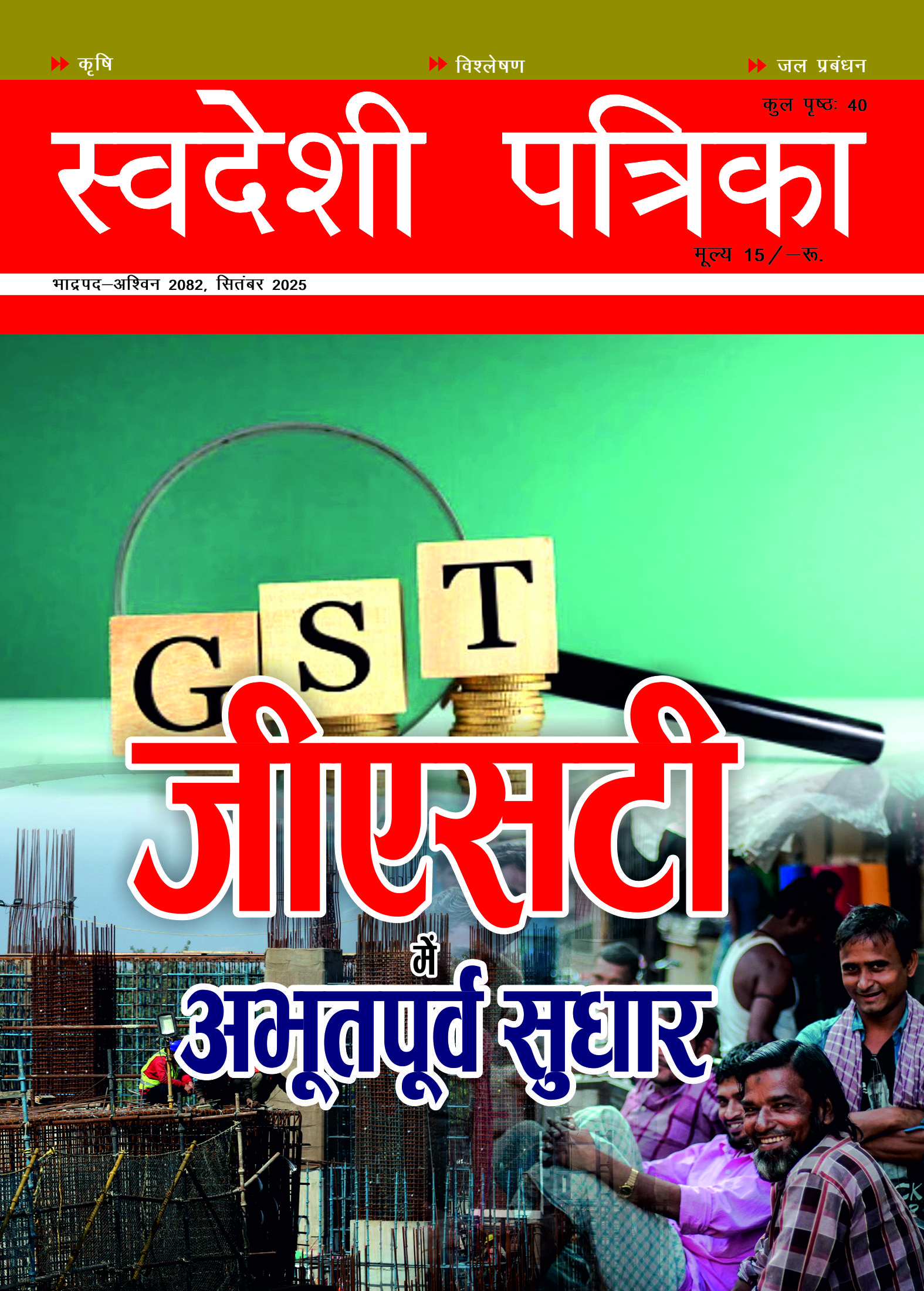
Resolution - 1 (NCM - Raipur (Jharkhand) - 9-10 March 2025)
Building Bharat Prosperous and Great Nation on Bharatiya Economic and Social Thought Process
Today we are living in a historic era of burgeoning youth population, fastest growing economy of the world, amidst digitalisation revolution, large and rapidly growing urban population. Despite the fact that country has encouraging achievements, advancing fast towards Industrial Revolution 4.0, thanks to progress in space, defence, digital economy, payment systems, quantum computing and abundance of resources, that keeps our economy in a vibrant situation through sustained demand and supply mechanism, there are still many challenges to make Bharat a prosperous and great nation. In view of possible socioeconomic challenges we may face in maintaining this momentum, there is a need to develop a comprehensive framework of holistic social & economic development based on Bhartiya thought process to help us in navigating our journey towards making Bharat a great and prosperous nation by 2047. A possible framework in line with Bharatiya thinking process is hereby proposed.
1. Decentralisation: The economy of Bharat used to be the world's leading economy contributing almost one-third of its GDP during the 16th and 17th century. The economic activities were organised on a decentralised basis, where the homes were production centers and villages were self-sufficient. The centralised planning process adopted after our Independence resulted in concentration of economic decision making at few places and regions that hindered the all round development of the country. Now with the development of infrastructure and IT, it is possible to shift to district level planning and support the development of businesses including traders, MSMEs, FMCG, handicrafts & artwares, agriculture and agribased units as per the available resources and needs of the area. There is a need to strengthen the planning process at district levels by leveraging the available expertise & resources and also incentivising the process. Swadeshi Jagran Manch believes in a decentralised development process in which DICs and KVKs can play pivotal roles in strengthening our rural economy, MSMEs sector, entrepreneurships and in solving the problems of unemployment, poverty & inequalities and take the country forward towards making it a prosperous and great nation.
2. Self-employment and Entrepreneurship focused Development: Our dominance of the world's economy almost till the end 18th century was based on entrepreneurship. The job seeking culture which Britishers encouraged still dominates the minds of our youth. Today the need is to support and accelerate entrepreneurial mindset and build a strong ecosystem for it. Focus on access to credit, technology, market and better management practices for assisting the youth and women entrepreneurs needs to be done on priority. The Economic Survey 2024-25, further points out that to productively engage the growing working population ,78.50 lacs non-farm jobs need to be created every year until 2030, which is only feasible through the route of self-employment and entrepreneurship. We recommend the creation of one Entrepreneurship Centre in every educational institution. We further feel the need for the Establishment of an Entrepreneurship Commission at the Centre and each State to initiate and accelerate entrepreneurship.
3. Protection to unorganized sector & Strengthening of Rural Economy: The unorganized sector (selfregulated) consists of 90 percent of Bharat’s workforce (Economic Survey of India 2021-22), where economic activities are largely unregulated. The sector has characteristics like low wages, poor working conditions, lack of job security, and limited social security benefits to workers. To improve the social and economic conditions of these workers, Swadeshi Jagran Manch demands the enforcement of existing minimum wage laws and regulations, and work together in laying down guidelines to effectively implement the policies concerning welfare of the workforce in this sector. Agriculture & allied sector , where most of the activities are unorganised is the backbone of our economy that contributes about 16 percent to our G.D.P. and employs around 46 percent of our population. Still 65 percent of people reside in villages. The challenges this sector faces can be handled by having a more diversified, efficient and sustainable rural economy, focusing on more investment, innovations, incentives and strengthening of institutions. Swadeshi Jagran Manch in particular favours strengthening of the Krishi Vigyan Kendras to motivate farmers in adopting new technologies and agri-practices, cooperative structures to promote Agri-startups & FPOs to boost investment, and raise their farm income.
4. Leverage Population Dividend: The demographic dividend refers to the economic growth potential arising from a shift in a country’s age structure, where the working-age population (15-59 years) outnumbers the non-working age groups. Our median age is around 29 years, compared to the ageing population of developed countries. The young population is the key driver of our growth potential, and to reap the benefits of population dividend we need to enhance the quality of, focus on skill & vocational training, entrepreneurship and self-employment; healthcare infrastructure, access to health-care facilities & nutrition for productive and healthy workforce; women’s empowerment, training and entrepreneurship opportunities; and a conducive business environment to facilitate innovations, startups, and employment opportunities to the rising workforce.
5. Stop Cultural Pollution: Cultural pollution is contamination or onslaught on our rich cultural values, traditions and practices. Internet, related communication technologies and social media has resulted in unmindful spread and adoption of western culture and values by our society, particularly by the youth. SJM resolves that “ Swa” based lifestyle - in our languages , food, dresses, festivals etc. should be embraced by all. Thus, the Indian Knowledge System and Swadeshi lifestyle should be promoted in a holistic manner. We need to inspire our youth by the success stories of our scientists, teachers, artists, entrepreneurs, thinkers, project them as their heroes, teach them with our rich cultural heritage and values by including them in the curriculum in the educational institutions. A national policy should be developed to regulate and check the contents delivered by the Internet and media companies. Few countries like Australia bans access to the Internet and social media to children below 16 years of age.
6. Check on imports from China: India’s trade deficit with China over a period of time is increasing. It was USD 44.86 bn (imports 58.20 USD bn and exports 13.4 USD bn) in 2015 which increased to USD 83.52 bn (imports 107 USD bn and exports 13.48 USD bn) in 2024. This relationship has raised concern regarding our stability, industrial self-reliance and supply chain disruption risks. Excessive Chinese imports have hurted our domestic industries badly. We must diversify our imports from other ASEAN and Western economies. We need to focus on improving the ease of doing business, infrastructure, and reduce redtapism to support local industries. Encouraging innovations, fostering entrepreneurship, incentivising domestic firms to invest in high-tech. manufacturing will be key to ensure long term resilience.
7. Unlocking the potential of Bharatiya Diaspora - possibility of brain gain: As per the study of the Ministry of External Affairs there are about 13.6 million NRIs (who are settled down seeking jobs) and 18.6 million PIOs (Overseas Citizens of India) in around 189 countries. The Bhartiya Diaspora produces an annual economic income of about $400 billion (13 percent of India's G.D.P.). Prominent Indians such as Sunder Pichai (Alphabet Inc.), Satya Nadella (Microsoft), Parag Aggarwal, (Twitter), Leena Nair (Channel), and Shantanu Narayan (Adobe Inc.) are leading the top companies of the world. Indians abroad are contributing to the development of different countries in diverse areas. Swadeshi Jagran Manch appeals to Bhartiya Diaspora to contribute through investment, remittances, mentoring youth towards entrepreneurship , build great Indian companies & brands and head prestigious projects essential for realising the vision of making Bharat prosperous & great. At the same time GOI should provide incentives to Bhartiya Diaspora on the pattern of PLI to incentivise their involvement in India’s growth story.
8. Policy on use of Artificial Intelligence & Robotics: The unprecedented advancements in artificial intelligence, robotics, machine learning and related technologies presents huge opportunities as well challenges to the world community. Having the potential of replacing human beings and performing functions of a human mind, it causes a lot of disruptions in the labour surplus country like ours. These technologies hold immense benefits if carefully used, but the indiscriminate application of such technologies would add to the problem of unemployment. Coordinated actions from all stakeholders and regulatory frameworks have to ensure that use of AI aligns with societal values, balancing innovations with transparency and accountability, shall make AI driven productivity to help in attaining an inclusive growth.
Summary: Presently , we are passing through the period of Amrit-kaal , which provides each one of us the unique opportunity to contribute towards making Bharat a prosperous and great nation by 2047. SJM, believes that by building a strong socio-economic structure based on the above discussion, we can realise this objective. SJM appeals to all to contribute towards this new and constructive Swadeshi Abhiyaan based on Bhartiya Vision of Development and realise the vision of making Bharat a prosperous and great nation in this Amrit kaal.


